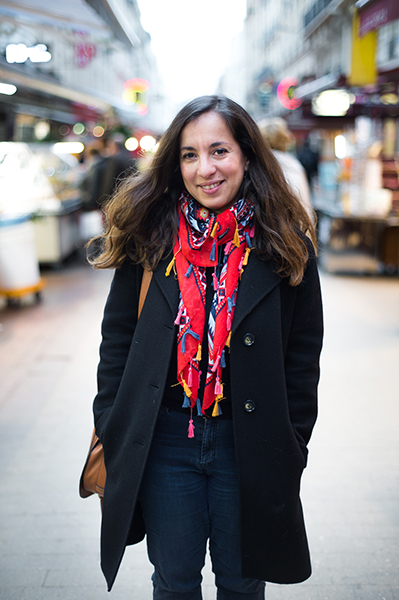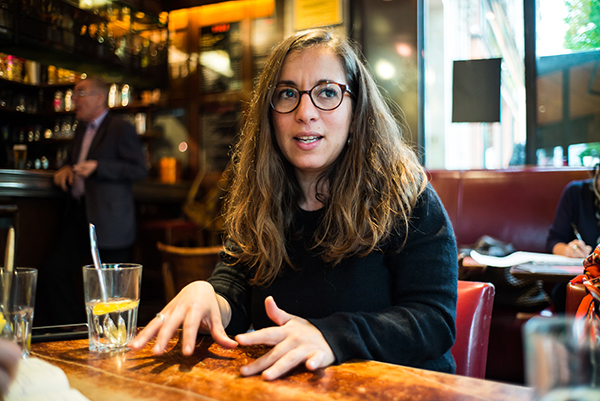 Yasmine Amhis, explorer of matter
Yasmine Amhis, explorer of matter Sky is not even the limit
After exceptional higher education studies, Yasmine Amhis, a researcher in particle physics, won the Jacques Herbrand prize by the French Academy of Science in 2016. Portrait of an energetic and modern young scientist.
The 2016 winner of the Jacques Herbrand Prize
Failures often lead to brilliant success. A researcher in particle physics at the CNRS, Yasmine Amhis is well aware of that. In 2001, she dropped out of her second first year in medical studies at the Paris-Sud university. But today, she is an internationally-recognised scientist. Despite this success, she is still humble and thinks about the community first:  "This is an individual award, but my work was achieved as a team", she said. In 2016, the French Academy of Science attributed the Jacques Herbrand Prize to her. This prize awards a researcher under 35 years old "whose work has been deemed useful to the progress of physics or their peaceful applications".
"This is an individual award, but my work was achieved as a team", she said. In 2016, the French Academy of Science attributed the Jacques Herbrand Prize to her. This prize awards a researcher under 35 years old "whose work has been deemed useful to the progress of physics or their peaceful applications".
Yasmine Amhis doesn't display the academic authority granted by her status of first class research fellow at the CNRS. Casually dressed, she is wearing jeans and sneakers. With a smile and good mood, she popularises and easily simplifies her research topic: "I work on what we call in particle physics the 'standard model'. It is used to describe matter, but doesn't explain all phenomena: not gravity or dark matter, for example." An experimental physicist, she is a member of the Laboratoire de l’accélérateur linéaire (Lal, "laboratory for linear accelerator") of the Paris-Sud university. She is a member of the research group working on the LHCb experiment (Large Hadron Collider beauty) that studies quark b, the ultimate atomic core described as a key element to comprehend the creation of the universe.
From Algiers to Orsay
Born on the other side of the Mediterranean Sea, Yasmine Amhis grew up in Algiers with two younger sisters and doctor parents. Her grandmother, a French teacher, opened her curiosity for the mysteries of mathematical logic when she was a teenager. Maybe her stories where the starting point of her passion. In any case, she chose the scientific path in high school. In her last year of high school, she may have thought for the first time about the career she now has without realizing it. "My physics teacher was awesome, says the young woman. His explanations were clear and fluent, it was wonderful".
After she passed her baccalauréat, Yasmine Amhis chose to study medicine. "I liked big machines such as scanners!" she says jokingly. But her first steps were the toughest. "I arrived in France at the beginning of classes. When I finally found a place to stay, I was already lagging. At the time, she discovered both the French higher education system and expatriation and the distance with her family. The gap was big. In addition, the first year of medical studies is frantic, and the atmosphere of constant contest daunts many students. "Students retaking the year were at the back of the class and threw paper planes to disturb the newcomers", she recalls.
Physics, my first love
After an unsuccessful first year, Yasmine Amhis gave it a second try but dropped out after a few months. She did not really like what she was doing. She recalls with a smile that "the only class that [she] liked was physical science". She then had a stroke of luck: the Orsay campus, open to students in first year of medical studies at Paris-Sud, is also one of the most famous campus in the Paris region for exact sciences.
Free of any obligation in the middle of the year, Yasmine Amhis spends her time in the university library. She reads scientific books and manuals. "I liked particle physics, she says. I liked the idea to reveal secrets of the world, such as the origins of the Big Bang". She also realised the opportunities given by the faculty of science at Orsay: the resources available, the place of fundamental research and cutting-edge labs such as for nuclear physics. She decided to redefine her objectives with the help of the orientation service of the university and presented her project to her parents: "After a month of debate, I convinced them to let me study physical science".
The next year, in a new physical science career, Yasmine discovered a very friendly atmosphere: "Far from what I had experimented in medical studies, we shared notes between students when one of us was sick". She was fascinated by teachers, "who were often teachers-researchers with thrilling discussions, most of all when you want to work in research" says the young physicist with a smile.
One step back, two steps forward
After she passed her Master 2, Yasmine Amhis worked in a pre-thesis internship at the Lal at Paris-Sud. In 2006,  her thesis scholarship allowed her to work on the LHCb experience in the same laboratory. When she finished her doctorate, she decided to join the CNRS. She went to Switzerland thinking that an experience abroad would be a plus for her resume. "I did a three-years post-PhD contract at the Swiss Federal Institute of Technology in Lausanne, where I worked on the LHCb experience". This choice paid off: in 2012, after two unsuccessful tries, Yasmine Amhis passed the entry exam of the CNRS.
her thesis scholarship allowed her to work on the LHCb experience in the same laboratory. When she finished her doctorate, she decided to join the CNRS. She went to Switzerland thinking that an experience abroad would be a plus for her resume. "I did a three-years post-PhD contract at the Swiss Federal Institute of Technology in Lausanne, where I worked on the LHCb experience". This choice paid off: in 2012, after two unsuccessful tries, Yasmine Amhis passed the entry exam of the CNRS.
Her adventures at the Orsay campus may now resume: "I was dispatched at the lab where I did my thesis" says the young researcher. Though her road seems a bit bumpy, Yasmine has a lucid opinion about her workplace and the limits others must successfully overcome. "Only 12% of researchers of the LHCb are women", she concludes.
Photos © Samuel Cortès/Animal pensant